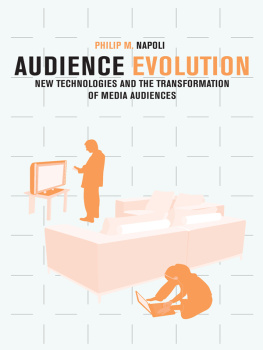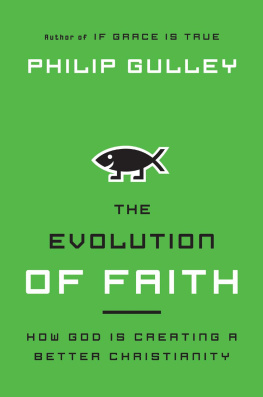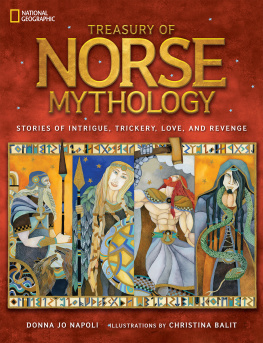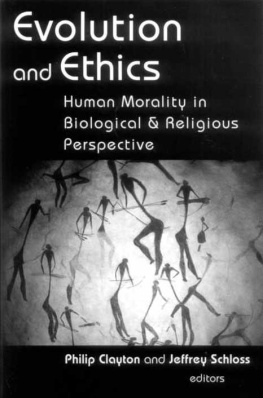Napoli Philip M. - Audience Evolution
Here you can read online Napoli Philip M. - Audience Evolution full text of the book (entire story) in english for free. Download pdf and epub, get meaning, cover and reviews about this ebook. year: 2011, publisher: Columbia University Press, genre: Politics. Description of the work, (preface) as well as reviews are available. Best literature library LitArk.com created for fans of good reading and offers a wide selection of genres:
Romance novel
Science fiction
Adventure
Detective
Science
History
Home and family
Prose
Art
Politics
Computer
Non-fiction
Religion
Business
Children
Humor
Choose a favorite category and find really read worthwhile books. Enjoy immersion in the world of imagination, feel the emotions of the characters or learn something new for yourself, make an fascinating discovery.
- Book:Audience Evolution
- Author:
- Publisher:Columbia University Press
- Genre:
- Year:2011
- Rating:4 / 5
- Favourites:Add to favourites
- Your mark:
- 80
- 1
- 2
- 3
- 4
- 5
Audience Evolution: summary, description and annotation
We offer to read an annotation, description, summary or preface (depends on what the author of the book "Audience Evolution" wrote himself). If you haven't found the necessary information about the book — write in the comments, we will try to find it.
Audience Evolution — read online for free the complete book (whole text) full work
Below is the text of the book, divided by pages. System saving the place of the last page read, allows you to conveniently read the book "Audience Evolution" online for free, without having to search again every time where you left off. Put a bookmark, and you can go to the page where you finished reading at any time.
Font size:
Interval:
Bookmark:
AUDIENCE EVOLUTION

NEW TECHNOLOGIES AND THE TRANSFORMATION OF MEDIA AUDIENCES
PHILIP M. NAPOLI
COLUMBIA UNIVERSITY PRESS
NEW YORK

COLUMBIA UNIVERSITY PRESS
Publishers Since 1893
New York Chichester, West Sussex
cup.columbia.edu
Copyright 2011 Columbia University Press
All rights reserved
E-ISBN 978-0-231-52094-2
Library of Congress Cataloging-in-Publication Data
Napoli, Philip M.
Audience evolution : new technologies and the transformation of media audiences / Philip M. Napoli.
p. cm.
Includes bibliographical references and index.
ISBN 978-0-231-15034-7 (cloth : alk. paper)ISBN 978-0-231-15035-4 (pbk. : alk. paper)ISBN 978-0-231-52094-2 (ebook)
1. Mass mediaAudiences. 2. Digital mediaTechnological innovations. I. Title.
P96.A83N35 2010
302.23dc22 2010023906
A Columbia University Press E-book.
CUP would be pleased to hear about your reading experience with this e-book at .
References to Internet Web sites (URLs) were accurate at the time of writing. Neither the author nor Columbia University Press is responsible for URLs that may have expired or changed since the manuscript was prepared.
TO BELLA, WHO MADE ME LAUGH EVERY DAY
CONTENTS
Figures
Tables
It wasnt long after I completed my 2003 book, Audience Economics, that I realized that the final chapter of that book, which considered the impact of technological changes on the marketplace for media audiences, could very easily be expanded into an entire book in its own right. The seven years since the publication of Audience Economics have included some of the most dramatic technological and economic changes in the history of our media system: the rise of social networking sites, to the point where social networking has eclipsed email as the most common online activity; the development of increasingly sophisticated hand-held devices such as the iPod, iPad, iPhone, and Kindle; the explosion of blogging and other forms of user-generated content, as well as platforms (such as YouTube and Twitter) for disseminating it; the transition to digital audio and video broadcasting; the rise of DVRs; the recession and, of course, the associated dramatic economic hardships that confront traditional media sectors such as newspapers, magazines, and broadcast television. All of these developments are contributing to a dramatic reconfiguration of the relationship between the media and their audiences.
Less visible to the casual observer, however, is another layer of developments that are also contributing to these changes. These revolve around the systems that media organizations and advertisers utilize to learn about their audiences, to measure their behavior, to predict future behavior, and to assign value to different segments of the audience. These measurement systems are the lifeblood of ad-supported media. And they too are changing dramatically, with these changes driven in large part by many of the technological changes mentioned previously. And so in recent years we have seen the launch of new systems for measuring television and radio audiences, new approaches to the measurement of Internet audiences, and a flurry of ongoing efforts to effectively capture the flow of audiences across so many new platforms for consuming media.
Examining how media industries seek to understand their audiences has always struck me as an interesting and fruitful path of inquiry for gaining a deeper understanding of these industries and how they go about producing and distributing the content that flows through our media system. Engaging in this kind of inquiry during a period of intense transition (some would say crisis), such as is currently taking place, struck me as particularly interesting.
And so this book represents an effort to extend a line of inquiry that I began with Audience Economicsone that focuses this time entirely on the subject of how new technologies are affecting the audience marketplace and that therefore treats this subject in much greater depth than was the case in Audience Economics. It is important to emphasize, though, that the hope here is to provide an analysis that not only contributes to an understanding of the developments that are taking place today, but also creates a useful framework for understanding developments that have taken place in the past, as well as those that will take place in the future.
This project spent a fair bit of time gestating, and I am grateful to a number of colleagues who endured early, somewhat half-baked, presentations of the ideas contained in this book. The faculties of the Department of Communication at the University of Michigan and the Medill School of Journalism were early, receptive, though challenging audiences for these ideas. I am also thankful for the opportunity I was provided to present parts of this project to audiences of media professionals at the Office of the Consulate General of Finland in New York, as well as to academic audiences at the International Communication Association 2008 and 2009 conferences, the International Association for Media and Communications Researchs 2008 conference, the Massachusetts Institute of Technologys Media in Transition 6 conference, and the University of Miamis Advances in Audience and Consumer Measurement conference. Thanks to Robert Picard of the Media Management and Transformation Centre and Walter McDowell of the University of Miami for including me in the latter.
Thanks are due to my Communications and Media Management Area chair, Everette Dennis, as well as to the dean of the Graduate School of Business, Howard Tuckman, and the Office of Academic Affairs of Fordham University, for awarding me a Magis Professorship, which provided me with three years of a reduced teaching load and therefore allowed me to devote more time to this project and to finish it much sooner than would probably otherwise have been the case. Fordham continues to provide me with a very hospitable and supportive research environment that, in the heart of New York City, could not be better situated for conducting research for a project such as this one.
A number of graduate and undergraduate research assistants were tremendously helpful in the completion of this project. These include Kurt Andrews, Adrienne Shiffman, Jackie Jay, Sheea Sybblis, Anne Halligan, Jessica Crowell, Amanda Trokan, Advaitha Arunkumar, Hyun Kyung Oh, Jeremy Brotchner, Adrienne Harth, Taryn Bensky, Lee Rosenberg, and Lindsay Kaufman. I hope Im not forgetting anyone.
Conversations with a number of colleagues, including Jim Webster of Northwestern University, Patricia Phalen of George Washington University, Joe Brown of Versus, Matthew Pagen of Nielsen IAG, David Gunzerath of the Media Ratings Council, Minna Aslama of the University of Helsinki, Gabriel Rossman of UCLA (who also emailed various useful bits of information over the past couple of years), and Paul Lavrakas (formerly of Nielsen), were all helpful in terms of fleshing out various parts of the book. Im appreciative of the time these individuals all took to speak with me.
Thanks are also due to Philip Leventhal of Columbia University Press for taking an interest in this project and shepherding it through the publication process and to Kerri Cox Sullivan for her expert copyediting. Three anonymous reviewers provided useful feedback on the proposal that helped me to refine the projects focus, as well as to make sure that important issues were not neglected. The feedback of two anonymous reviewers on the completed manuscript also helped me to refine some points and improve some areas of ambiguity. The book is much better for these reviewers input, though of course its remaining shortcomings are entirely my doing.
Next pageFont size:
Interval:
Bookmark:
Similar books «Audience Evolution»
Look at similar books to Audience Evolution. We have selected literature similar in name and meaning in the hope of providing readers with more options to find new, interesting, not yet read works.
Discussion, reviews of the book Audience Evolution and just readers' own opinions. Leave your comments, write what you think about the work, its meaning or the main characters. Specify what exactly you liked and what you didn't like, and why you think so.








